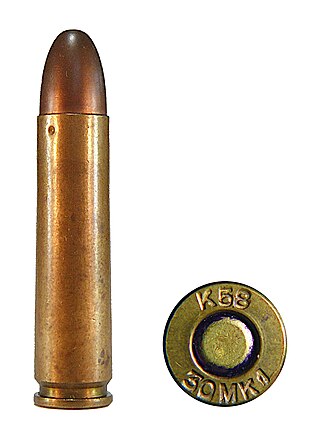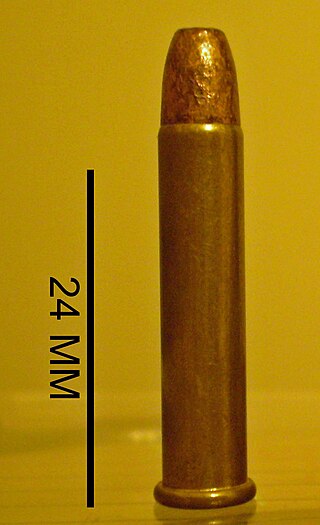
The 5.56×45mm NATO is a rimless bottlenecked centerfire intermediate cartridge family developed in the late 1970s in Belgium by FN Herstal. It consists of the SS109, L110, and SS111 cartridges. On 28 October 1980, under STANAG 4172, it was standardized as the second standard service rifle cartridge for NATO forces as well as many non-NATO countries. Though they are not identical, the 5.56×45mm NATO cartridge family was derived from and is dimensionally similar to the .223 Remington cartridge designed by Remington Arms in the early 1960s.

A cartridge, also known as a round, is a type of pre-assembled firearm ammunition packaging a projectile, a propellant substance and an ignition device (primer) within a metallic, paper, or plastic case that is precisely made to fit within the barrel chamber of a breechloading gun, for convenient transportation and handling during shooting. Although in popular usage the term "bullet" is often used to refer to a complete cartridge, the correct usage only refers to the projectile.

In guns, particularly firearms, but not artillery, where a different definition may apply, caliber is the specified nominal internal diameter of the gun barrel bore – regardless of how or where the bore is measured and whether the finished bore matches that specification. It is measured in inches or in millimeters. In the United States it is expressed in hundredths of an inch; in the United Kingdom in thousandths; and elsewhere in millimeters. For example, a US "45 caliber" firearm has a barrel diameter of roughly 0.45 inches (11.43mm). Barrel diameters can also be expressed using metric dimensions. For example, a "9 mm pistol" has a barrel diameter of about 9 millimeters. Since metric and US customary units do not convert evenly at this scale, metric conversions of caliber measured in decimal inches are typically approximations of the precise specifications in non-metric units, and vice versa.

A rim-fire is a type of metallic cartridge used in firearms where the primer is located within a hollow circumferential rim protruding from the base of its casing. When fired, the gun's firing pin will strike and crush the rim against the edge of the barrel breech, sparking the primer compound within the rim, and in turn ignite the propellant within the case. Invented in 1845 by Louis-Nicolas Flobert, the first rimfire metallic cartridge was the .22 BB Cap cartridge, which consisted of a percussion cap with a bullet attached to the top. While many other different cartridge priming methods have been tried since the early 19th century, such as teat-fire and pinfire, only small caliber rimfire cartridges have survived to the present day with regular use. The .22 Long Rifle rimfire cartridge, introduced in 1887, is by far the most common ammunition found in the world today in terms of units manufactured and sold.

The .22 long rifle, also known as the .22 LR or 5.7×15mmR, is a long-established variety of .22 caliber rimfire ammunition originating from the United States. It is used in a wide range of firearms including rifles, pistols, revolvers, and submachine guns.

The .223 Remington is a rimless, bottlenecked, centerfire intermediate cartridge. It was developed in 1957 by Remington Arms and Fairchild Industries for the U.S. Continental Army Command of the United States Army as part of a project to create a small-caliber, high-velocity firearm. The .223 Remington is considered one of the most popular common-use cartridges and is used by a wide range of semi-automatic and manual-action rifles.
The .30-06 Springfield cartridge, 7.62×63mm in metric notation, and called the .30 Gov't '06 by Winchester, was introduced to the United States Army in 1906 and later standardized; it remained in military use until the late 1970s. In the cartridge's name, ".30" refers to the nominal caliber of the bullet in inches; "06" refers to the year the cartridge was adopted, 1906. It replaced the .30-03 Springfield, 6mm Lee Navy, and .30-40 Krag cartridges. The .30-06 remained the U.S. Army's primary rifle and machine gun cartridge for nearly 50 years before being replaced by the 7.62×51mm NATO and 5.56×45mm NATO, both of which remain in current U.S. and NATO service. The cartridge remains a very popular sporting round, with ammunition produced by all major manufacturers.

The .303 British or 7.7×56mmR, is a .303-inch (7.7 mm) calibre rimmed tapered bottleneck centerfire rifle cartridge. The .303 inch bore diameter is measured between rifling lands as is the common practice in Europe which follows the traditional black powder convention.

.22 short is a variety of .22 caliber rimfire ammunition. Developed in 1857 for the first Smith & Wesson revolver, the .22 rimfire was the first American metallic cartridge. The original loading was a 29 or 30 gr bullet and 4 gr of black powder. The original .22 rimfire cartridge was renamed .22 short with the introduction of the .22 long in 1871.

The .30 carbine is a rimless carbine/rifle cartridge used in the M1 carbine introduced in the 1940s. It is a light rifle round designed to be fired from the M1 carbine's 18-inch (458 mm) barrel.

The .22 Winchester Magnum Rimfire, also known as the .22 WMR, .22 Magnum, .22 WMRF, .22 MRF, or .22 Mag, is a rimfire cartridge. Originally loaded with a bullet weight of 40 grains (2.6 g) delivering velocities in the 2,000 feet per second (610 m/s) range from a rifle barrel, .22 WMR is now loaded with bullet weights ranging from 50 grains (3.2 g) at 1,530 feet per second (470 m/s) to 30 grains (1.9 g) at 2,200 feet per second (670 m/s).
The Spencer repeating rifle was a 19th-century American lever-action firearm invented by Christopher Spencer. The Spencer carbine was a shorter and lighter version designed for the cavalry.

The .45-70 (11.6x53mmR), also known as the .45-70 Government, .45-70 Springfield, and .45-21⁄10" Sharps, is a .45 caliber rifle cartridge originally holding 70 grains of black powder that was developed at the U.S. Army's Springfield Armory for use in the Springfield Model 1873. It was a replacement for the stop-gap .50-70 Government cartridge, which had been adopted in 1866, one year after the end of the American Civil War, and is known by collectors as the "Trapdoor Springfield".
The .30-03 Springfield (7.62×65mm) was a short-lived cartridge developed by the United States in 1903, to replace the .30-40 Krag in the new Springfield 1903 rifle. The .30-03 was also called the .30-45, since it used a 45 grain powder charge; the name was changed to .30-03 to indicate the year of adoption. It used a 220 grain roundnose bullet. It was replaced after only three years of service by the .30-06, firing a spitzer bullet that had better ballistic performance.

The .50-90 Sharps (13x64mmR), also known as the .50-21⁄2" Sharps, is a black-powder rifle cartridge that was introduced by Sharps Rifle Manufacturing Company in 1872 as a buffalo hunting round. Like other large black-powder rounds, it incorporates a heavy bullet and a large powder volume, leading to high muzzle energies.

The .44 Henry, also known as the .44 Henry Flat, the .44 Rimfire, the .44 Long Rimfire, and the 11x23mmRF in Europe, is a rimfire rifle and handgun cartridge featuring a .875 in (22.2 mm)-long brass or copper case. The round has a total overall length of 1.345 in (34.2 mm), with a 200 or 216 gr .446 in (11.3 mm)-diameter cast solid-lead heeled bullet. The original propellant load is 26 to 28 gr of black powder. The round has a muzzle velocity of approximately 1,125 ft/s (343 m/s), giving a muzzle energy of 568 foot-pounds.
The .500 S&W Magnum or 12.7×41mmSR is a .50 caliber semi-rimmed revolver cartridge developed by Cor-Bon in partnership with the Smith & Wesson "X-Gun" engineering team for use in the Smith & Wesson Model 500 X-frame revolver and introduced in February 2003 at the SHOT Show. It was intended to be the most powerful handgun cartridge to date, with the capacity to harvest all North American game species. More powerful handgun cartridges, such as the .500 Bushwhacker, have emerged since, however.
Frank Wesson rifles were a series of single-shot rifles manufactured between 1859 and 1888 in Worcester, Massachusetts. They were purchased by many state governments during the American Civil War, including Illinois, Indiana, Kansas, Kentucky, Missouri, and Ohio. They were one of the first rifles to use rimfire metallic cartridges.
The .277 Wolverine (6.8x39mm) is a wildcat cartridge. It is a multi-purpose mid-power cartridge with increased ballistic performance over the AR-15's traditional .223 Remington cartridge. The use of a modified 5.56 case means that at minimum, only a new barrel is needed to convert any 5.56-based firearm to .277 Wolverine.














